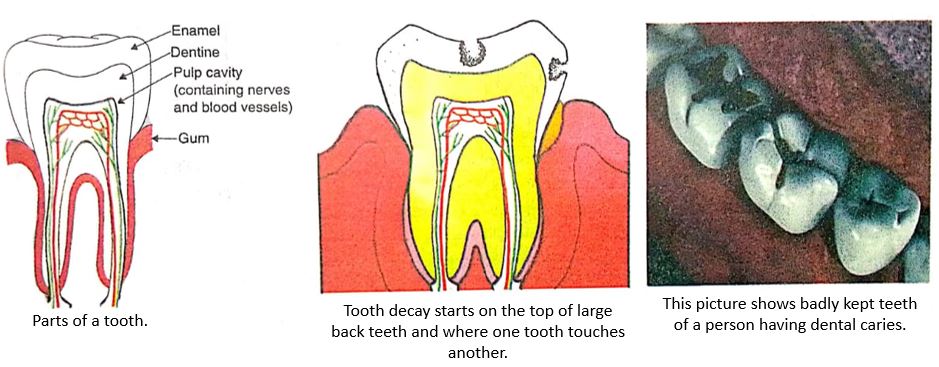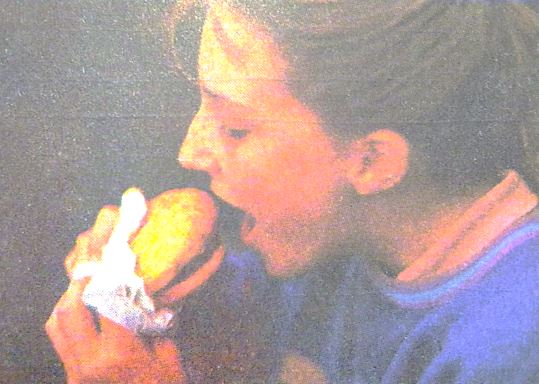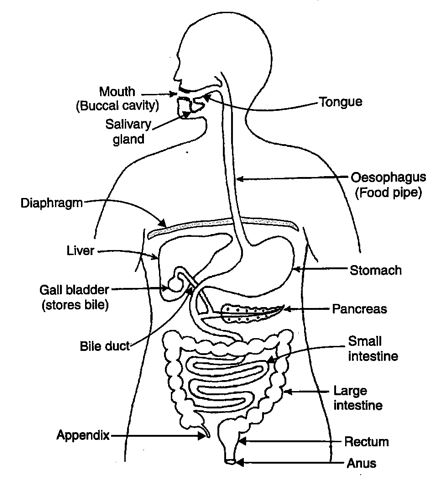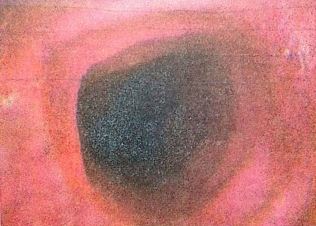The nutrition in human beings (or man) takes place through human digestive system. The human digestive system consists of the alimentary canal and its associated glands. The various organs of the human digestive system in sequence are : Mouth, Oesophagus (or Food pipe), Stomach, Small intestine and Large intestine. The glands which are associated with the human digestive system and form a part of the human digestive system are : Salivary glands, Liver and Pancreas. The human alimentary canal which runs from mouth to anus is about 9 metres long tube. The ducts of various glands open into the alimentary canal and pour the secretions of the digestive juices into the alimentary canal. We will now describe the various steps of nutrition in human beings (or man).
1. Ingestion
Contents
- 1 Dental Caries
- 2 🧠 Overview:
- 3 🧬 Major Organs of the Digestive System (In Order)
- 4 🧪 Accessory Organs (Not part of the digestive tract but aid in digestion)
- 5 ⚙️ Digestive Process Steps (Simplified):
- 6 🔬 Important Enzymes & Juices:
- 7 📌 Diseases/Disorders Related to Digestive System:
The human beings have a special organ for the ingestion of food. It is called mouth.
The digestion of food starts as soon as we put food in our mouth.
So, in human beings, food is ingested through the mouth. The food is put into the mouth with the help of hands.
2. Digestion
In human beings, the digestion of food begins in the mouth itself. In fact, the digestion of food starts as soon as we put food in our mouth. This happens as follows: The mouth cavity (or buccal cavity) contains teeth, tongue, and salivary glands. The teeth cut the food into small pieces, chew and grind it. So, the teeth help in physical digestion. The salivary glands in our mouth produce saliva. Our tongue helps in mixing this saliva with food. Saliva is a watery liquid so it wets the food in our mouth. The wetted food can be swallowed more easily. Many times we have observed that when we see or eat a food which we really like, our mouth ‘waters’. This watering of mouth is due to the production of saliva by the salivary glands in the mouth The salivary glands help in chemical digestion by secreting enzymes. The human saliva contains an enzyme called salivary amylase which digests the starch present in food into sugar. Thus, the digestion of starch (carbohydrate) begins in the mouth itself. Since the food remains in the mouth only for a short time, so the digestion of food remains incomplete in mouth.
The human digestive system.
The slightly digested food in the mouth is swallowed by the tongue and goes down the food pipe called oesophagus. The oesophagus carries food to the stomach. This happens as follows The walls of food pipe have muscles which can contract and expand alternately. When the slightly digested food enters the food pipe, the walls of food pipe start contraction and expansion movements. The contraction and expansion movement of the walls of food pipe is called peristaltic movement. This peristaltic movement of food pipe (or oesophagus) pushes the slightly digested food into the stomach (In fact, the peristaltic movement moves the food in all the digestive organs throughout the alimentary canal).
The inner side of food pipe (or oesophagus) as viewed by an endoscope.
The stomach is a J-shaped organ present on the left side of the abdomen. The food is further digested in the stomach. The food is churned in the stomach for about three hours. During this time, the food breaks down into still smaller pieces and forms a semi-solid paste. The stomach wall contains three tubular glands in its walls. The glands present in the walls of the stomach secrete gastric juice. The gastric juice contains three substances : hydrochloric acid, the enzyme pepsin and mucus. Due to the presence of hydrochloric acid, the gastric juice is acidic in nature. In the acidic medium, the enzyme pepsin begins the digestion of proteins present in food to form smaller molecules. Thus, the protein digestion begins in the stomach. Please note that the protein digesting enzyme pepsin is active only in the presence of an acid. So, the function of hydrochloric acid in the stomach is to make the medium of gastric juice acidic so that the enzyme pepsin can digest the proteins properly. Another function of hydrochloric acid is that it kills any bacteria which may enter the stomach with food. The mucus helps to protect the stomach wall from its own secretions of hydrochloric acid. If mucus is not secreted, hydrochloric acid will cause the erosion of inner lining of stomach leading to the formation of ulcers in the stomach. The partially digested food then goes from the stomach into the small intestine. The exit of food from stomach is regulated by a ‘sphincter muscle’ which releases it in small amounts into the small intestine.
From the stomach, the partially digested food enters the small intestine. The small intestine is the largest part of the alimentary canal. It is about 6.5 metres long in an adult man. Though the small intestine is very long, it is called small intestine because it is very narrow. The small intestine is arranged in the form of a coil in our belly. Please note that the length of the small intestine differs in various animals depending on the type of food they eat. For example, cellulose is a carbohydrate food which is digested with difficulty. So, the herbivorous animals like cow which eat grass need a longer ‘small intestine to allow the cellulose present in grass to be digested completely. On the other hand, meat is a food which is easier to digest. So, the carnivorous animals like tigers which eat meat have a shorter ‘small intestine’.
The small intestine in human beings is the site of complete digestion of food (like carbohydrates, proteins and fats). This happens as follows:
(a) The small intestine receives the secretions of two glands : liver and pancreas.
Liver secretes bile. Bile is a greenish yellow liquid made in the liver which is normally stored in the gall bladder. Bile is alkaline, and contains salts which help to emulsify or break the fats (or lipids) present in the food. Thus, bile performs two functions :
(i) makes the acidic food coming from the stomach alkaline so that pancreatic enzymes can act on it, and
(ii) bile salts break the fats present in the food into small globules making it easy for the enzymes to act and digest them. Pancreas is a large gland which lies parallel to and beneath the stomach. Pancreas secretes pancreatic juice which contains digestive enzymes like pancreatic amylase, trypsin and lipase. The enzyme amylase breaks down the starch, the enzyme trypsin digests the proteins and the enzyme lipase breaks down the emulsified fats.

(b) The walls of small intestine contain glands which secrete intestinal juice.
The intestinal juice contains a number of enzymes which complete the digestion of complex carbohydrates into glucose, proteins into amino acids and fats into fatty acids and glycerol. Glucose, amino acids, fatty acids and glycerol are small, water soluble molecules. In this way, the process of digestion converts the large and insoluble food molecules into small, water soluble molecules. The chemical digestion of food is brought about by biological catalysts called enzymes.
3. Absorption
After digestion, the molecules of food become so small that they can pass through the walls of the small intestine (which contain blood capillaries) and go into our blood. This is called absorption. The small intestine is the main region for the absorption of digested food. In fact, the small intestine is especially adapted for absorbing the digested food. The inner surface of small intestine has millions of tiny, finger-like projections called villi. The presence of villi gives the inner walls of the small intestine a very large surface area. And the large surface area of small intestine helps in the rapid absorption of digested food. The digested food which is absorbed through the walls of the small intestine, goes into our blood.

4. Assimilation
The blood carries digested and dissolved food to all the parts of the body where it becomes assimilated as part of the cells. This assimilated food is used by the body cells for obtaining energy as well as for growth and repair of the body. The energy is released by the oxidation of assimilated food in the cells during respiration. The digested food which is not used by our body immediately is stored in the liver in the form of a carbohydrate called ‘glycogen’. This stored glycogen can be used as a source of energy by the body as and when required.
5. Egestion
A part of the food which we eat cannot be digested by our body. This undigested food cannot be absorbed in the small intestine. So, the undigested food passes from the small intestine into a wider tube called large intestine (It is called large intestine because it is a quite wide tube). The walls of large intestine absorb most of the water from the undigested food (with the help of villi). Due to this, the undigested part of food becomes almost solid. The last part of the large intestine called ‘rectum’ stores this undigested food for some time. And when we go to the toilet, then this undigested food is passed out (or egested) from our body through anus as faeces or ‘stool’. The act of expelling the faeces is called egestion or defecation. The exit of faeces is controlled by the anal sphincter.
Let us solve one problem now.
Question. 1 mL of very dilute starch solution (1% starch solution) is taken in a test-tube and 1 mL of saliva is added to it. After keeping this mixture for half an hour, a few drops of dilute iodine solution are added to the test-tube. There is no change in colour on adding iodine solution. What does this tell you about the action of saliva on starch?
Answer. When a mixture of dilute starch solution and saliva is kept in a test-tube for half an hour, it does not produce a blue-black colour with iodine solution showing that no starch is left in the test-tube. This tells us that the action of saliva has broken down starch into some other substance which does not give any colour with iodine solution. Actually, saliva contains an enzyme ‘amylase’ which converts starch into a sugar.
- Nutrition: Mode of Nutrition and Types
- Nutrition in Plants
- Nutrition in Animals
- Nutrition in Amoeba
- Human Circulatory System
- What are Life Processes
Dental Caries
The hard, outer covering of a tooth is called enamel. Tooth enamel is the hardest material in our body. It is harder than even bones. The part of tooth below enamel is called dentine. Dentine is similar to bone Inside the pulp cavity. The pulp cavity contains nerves and blood vessels. The formation of small cavities (or holes) in the teeth due to the action of acid-forming bacteria and improper dental care is called dental caries. This happens as follows.

When we eat sugary food, the bacteria in our mouth act on sugar to produce acids. These acids first dissolve the calcium salts from the tooth enamel and then from dentine forming small cavities (or holes) in the tooth over a period of time. The formation of cavities reduces the distance between the outside of the tooth and the pulp cavity which contains nerves and blood vessels. The acids produced by bacteria irritate the nerve endings inside the tooth and cause toothache. If the cavities caused by dental decay are not cleaned and filled by a dentist, the bacteria will get into the pulp cavity of tooth causing inflammation and infection leading to severe pain.
If the teeth are not cleaned regularly, they become covered with a sticky, yellowish layer of food particles and bacteria cells called ‘dental plaque’. Since plaque covers the teeth forming a layer over them, the alkaline saliva cannot reach the tooth surface to neutralise the acid formed by bacteria and hence tooth decay sets in. Brushing the teeth regularly, after eating food, removes the plaque before bacteria produces acids. This will prevent dental caries or tooth decay.
You can write your questions and suggestions to us in the comment box given below.
Thank you
The human digestive system is a complex series of organs and glands that processes food so the body can absorb essential nutrients and eliminate waste. Here’s a breakdown of the structure, function, and key components:
🧠 Overview:
The digestive system converts food into energy and basic nutrients to feed the entire body. This process involves ingestion, digestion, absorption, and elimination.
🧬 Major Organs of the Digestive System (In Order)
1. Mouth (Oral Cavity)
-
Function: Chews food, mixes it with saliva (which contains enzymes like amylase that begin starch digestion).
-
Teeth & Tongue: Help in mechanical breakdown and swallowing.
2. Pharynx & Esophagus
-
Pharynx (Throat): Pathway for food from mouth to esophagus.
-
Esophagus: Muscular tube that pushes food into the stomach via peristalsis (wave-like muscle contractions).
3. Stomach
-
Function: Secretes gastric juices (including HCl and pepsin) to break down proteins.
-
Food is turned into chyme (a semi-liquid mixture).
4. Small Intestine (Duodenum, Jejunum, Ileum)
-
Duodenum: Receives bile (from liver) and pancreatic enzymes.
-
Jejunum & Ileum: Absorb nutrients into the bloodstream.
-
Key Function: Major site of digestion and absorption.
5. Large Intestine (Colon)
-
Function: Absorbs water and minerals; forms solid waste (feces).
-
Parts: Cecum, Ascending, Transverse, Descending & Sigmoid Colon, Rectum.
6. Rectum & Anus
-
Rectum: Stores feces.
-
Anus: Expels waste during defecation.
🧪 Accessory Organs (Not part of the digestive tract but aid in digestion)
🔸 Liver
-
Produces bile (helps break down fats).
-
Processes nutrients absorbed from the small intestine.
🔸 Gallbladder
-
Stores and releases bile into the duodenum.
🔸 Pancreas
-
Produces digestive enzymes and bicarbonate (neutralizes stomach acid).
-
Also produces insulin (related to blood sugar regulation).
⚙️ Digestive Process Steps (Simplified):
-
Ingestion – Taking in food.
-
Propulsion – Swallowing and peristalsis move food.
-
Mechanical digestion – Chewing, churning in stomach.
-
Chemical digestion – Enzymes break down food molecules.
-
Absorption – Nutrients absorbed into blood/lymph (mostly in small intestine).
-
Defecation – Elimination of indigestible substances as feces.
🔬 Important Enzymes & Juices:
| Enzyme/Juice | Origin | Function |
|---|---|---|
| Salivary Amylase | Mouth | Starch → Sugar |
| Pepsin + HCl | Stomach | Proteins → Peptides |
| Bile | Liver (via Gallbladder) | Fat emulsification |
| Pancreatic Enzymes | Pancreas | Break down proteins, carbs, fats |
| Intestinal Enzymes | Small Intestine | Final digestion of all food groups |
📌 Diseases/Disorders Related to Digestive System:
-
Gastritis / Ulcers – Inflammation or sores in stomach lining
-
Constipation / Diarrhea – Issues with bowel movement
-
GERD (Acid reflux) – Stomach acid enters esophagus
-
Liver diseases – Hepatitis, fatty liver
-
IBS / Crohn’s disease – Chronic intestinal disorders
Would you like a diagram of the digestive system or a Hindi version of this explanation as well?



